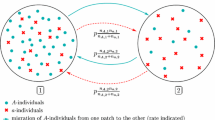Abstract
The crucial phase of speciation is argued to be the evolution of mating cross-incompatibility (prezygotic incompatibility) between the genotypes distinguishing the prospective species populations. Based on this idea, a single-locus model of speciation is presented, which is shown to be biologically plausible and may help to settle the controversy as to the biological significance of single-locus modes of speciation. The model involves three alleles, two of which characterize in homozygous state the prospective species populations and in heterozygous state their “hybrids”. The third allele represents a mutant which is equivalent to one of the first two alleles with the exception that it inhibits mating with carriers of the third allele. This third allele is fixed in one population and immigrates into a second population which contains the mutant inhibiting matings with members of the former population. Migration in the reverse direction does not occur. Proceeding from a widely applicable concept of fitness and mating preference it is shown that postzygotic incompatibility (hybrid or heterozygote disadvantage) alone suffices to trigger evolutionary replacement of the extant mating relations in the population receiving immigrants by any arbitrary degree of prezygotic incompatibility. This corroborates Wallace's hypothesis and emphasizes the potential biological relevance of speciation by reinforcement (parapatric speciation) at single gene loci.
Similar content being viewed by others
References
Coyne, J.A. and H.A. Orr (1989). Patterns of speciation in Drosophila. Evolution 43: 362–381.
Cooke, F., G.H. Finney and R.F. Rockwell (1976). Assortative mating in lesser snow geese (Anser caerulescens). Behav. Genet. 6: 127–140.
Dobzhansky, Th. (1941). Genetics and the Origin of Species. New York, Columbia Univ. Press.
Endler, J.A. (1977). Geographic Variation. Speciation, and Clines. Princeton, NJ, Princeton University Press.
Grant, V. (1966). The selective origin of incompatibility barriers in the plant genus Gilia. Amer. Nat. 100: 99–118.
Gregorius, H.-R. (1989). Characterization and Analysis of Mating Systems. Witzenhausen, Ekopan Verlag.
Gregorius, H.-R. (1991). Population genetic keys to speciation. Evolutionary Theory. Submitted.
Karlin, S. (1969). Equilibrium Behavior of Population Genetic Models with Non-Random Mating. New York, London, Paris, Gordon and Breach.
Maynard Smith, J. (1966). Sympatric speciation. Amer. Nat. 100: 637–650.
O'Donald, P. (1980). Genetic Models of Sexual Selection. Cambridge, Cambridge University Press.
Orr, H.A. (1991). Is single-gene speciation possible? Evolution 45: 764–769.
Sanderson, N. (1989). Can gene flow prevent reinforcement? Evolution 43: 1223–1235.
Slatkin, M. (1982). Pleiotropy and parapatric speciation. Evolution 36: 263–270.
Tauber, C.A. and M.J. Tauber (1977). A genetic model for sympatric speciation through habitat diversification and seasonal isolation. Nature 268: 702–705.
Udovic, D. (1980). Frequency dependent selection, disruptive selection, and the evolution of reproductive isolation. Amer. Nat. 116: 621–641.
Wallace, A.R. (1889). Darwinism — An Exposition of the Theory of Natural Selection With Some of its Applications. London, New York, Macmillan.
Author information
Authors and Affiliations
Rights and permissions
About this article
Cite this article
Gregorius, HR. A single-locus model of speciation. Acta Biotheor 40, 313–319 (1992). https://doi.org/10.1007/BF00046330
Received:
Issue Date:
DOI: https://doi.org/10.1007/BF00046330




